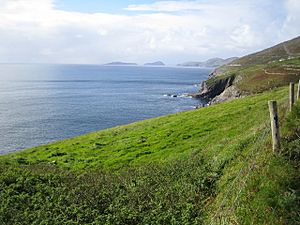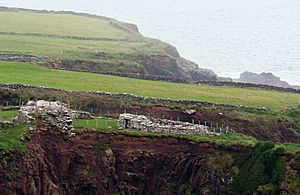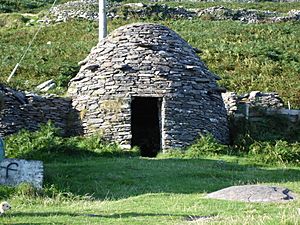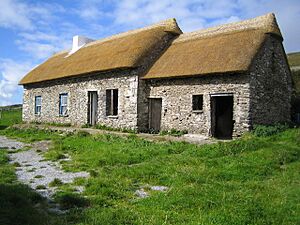Fahan, County Kerry facts for kids
Quick facts for kids Fahan |
|
|---|---|

Fahan: The Dingle Peninsula coastline looking towards Slea Head and the Blasket Islands from the R559 road
|
|
| Location | County Kerry, Ireland |
| Built | 13th century |
| Architectural style(s) | clochán |
| Lua error in Module:Location_map at line 420: attempt to index field 'wikibase' (a nil value). | |
Fahan is a special place on the Dingle Peninsula in County Kerry, Ireland. It's famous for its amazing collection of stone "beehive huts" called clochán. Imagine small, round buildings made only of stones, stacked carefully without any cement!
Fahan is located on the southern coast of the Dingle Peninsula. It sits below a mountain called Mount Eagle. To its west are the tall cliffs of Slea Head, and to its east is the fishing village of Ventry. Fahan is full of ancient treasures. You can find old cave homes, stone beehive huts, stone monuments, and even old forts here.
Contents
Dunbeg Fort: An Ancient Stone Fortress
Dunbeg Fort is an old stone fort built on a rocky piece of land. This land sticks out into Dingle Bay. Over many years, the sea has worn away the cliffs. Because of this, some parts of the fort have been lost to the ocean.
The fort's strong wall blocked off the triangular piece of land. Later, a single large "beehive" hut was built inside this protected area. Today, there's a visitor center at the fort. It has cool videos, information, a craft shop, and a place to eat.
When Was Dunbeg Fort Built?
It's hard to know exactly when Dunbeg Fort was built. But its design is similar to other old stone forts in Western Ireland. Experts think it might have been built around the same time as some forts in Scotland. These include places like the Crosskirk Fort and the Clickimin Fort. Some believe it was built during the Iron Age, a very long time ago.
Clochán: The Beehive Huts of Fahan
The collection of beehive huts at Fahan is truly amazing. Many people say it's one of the most remarkable groups in all of Ireland. It's tricky to know exactly how old these Fahan clochán are. This is because people have been building stone huts like these for thousands of years. They were built from the Neolithic period (Stone Age) all the way up to the 1900s.
Some of the very first clochán might have been built by monks who lived alone. However, most of the beehive huts you see in Fahan today are thought to be from the 1100s. This was a time when invaders from Normandy (France) forced farmers to move to less fertile lands. These farmers then settled in places like the Dingle Peninsula.
What Are Clochán Like?
Some of the stone huts in Fahan are found inside stone ring forts. These ring forts, called cashels in Irish, and the clochán form two main groups. People have counted 460 structures in total. Out of these, 414 are clochán.
Most of these huts are very old. But some were even built in the mid-1800s! They come in different sizes, from about 4 feet to 22 feet across. Most are round, but some are D-shaped or oval. They would have had special stone roofs. These roofs were built by stacking stones in circles, getting smaller and smaller towards the top. This gave them their unique beehive shape.
Kavanaugh Famine Cottage: A Glimpse into the Past
The Kavanaugh Famine Cottage is another interesting place to visit in Fahan. It's a special tourist attraction. This cottage once had two rooms and a small sleeping area upstairs.
The cottage has been carefully restored. Now it has three rooms and two small outdoor buildings. Inside, you can see furniture and items from the time of the Great Irish Famine. This terrible time happened between 1845 and 1853. The cottage is located on the north side of the R559 road. It's just west of the car park for Dunbeg Fort.
Images for kids







